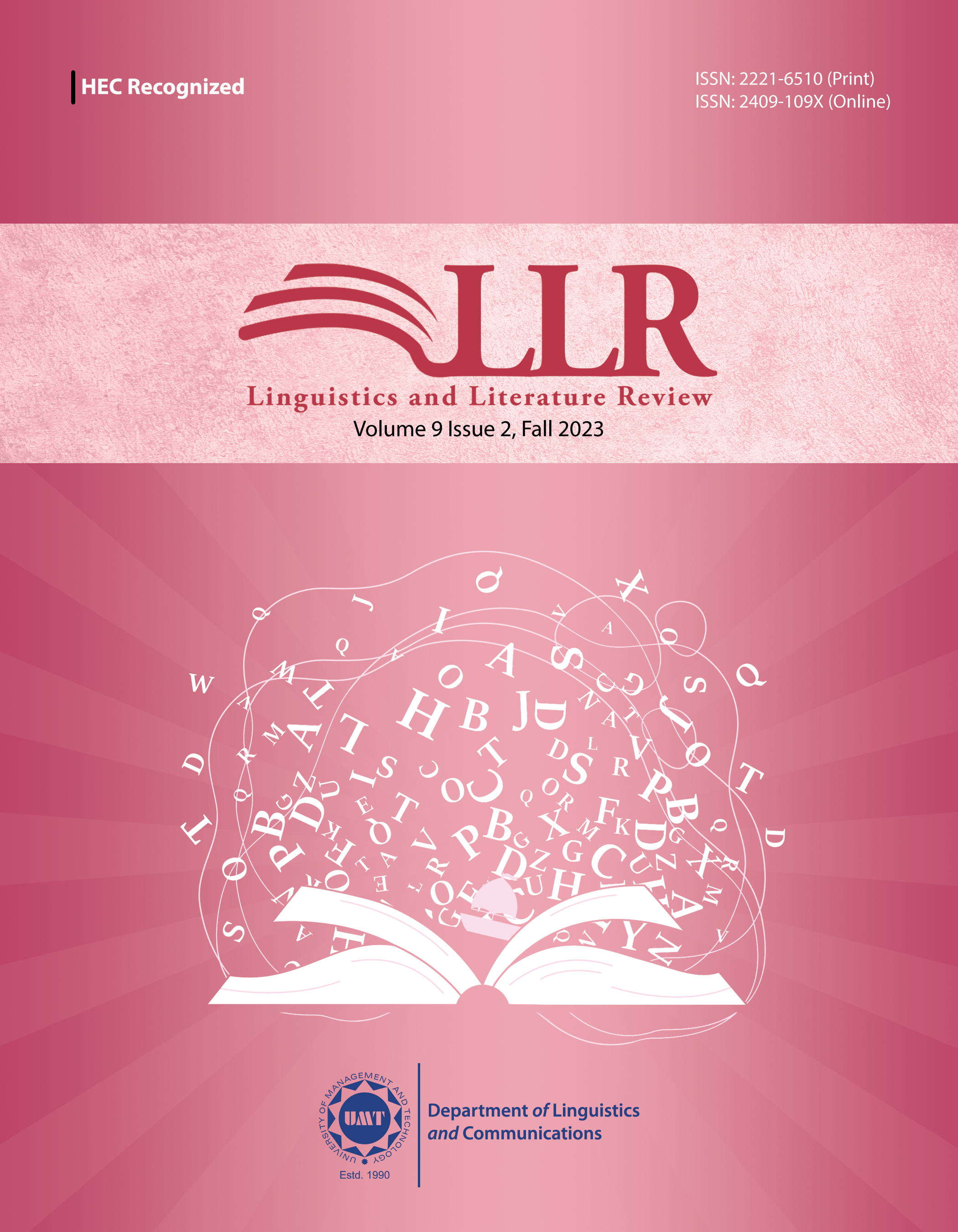Analyzing Recent (2019) Kashmir Socio-Political Issue: A Voyant Sentiment Analysis of Tweets
Abstract
 Abstract Views: 0
Abstract Views: 0
Computational Textual Analysis (CTA) is an effective way to analyze large texts by incorporating computational tools, such as, Voyant. The current study takes computer-assisted textual analysis (mixed method) to investigate the sentiments on tweets through Voyant computational method, in order to grasp the emotions of the global public who have tweeted about the recent (2019) Kashmir issue. This research is based on the conceptual framework of Ortony, Clore, and Collins (OCC) model and the keyword approach. For this purpose, different tweets have been analyzed to check the level of sentiments as either positive, negative or neutral. The findings suggested that sentiments were neutral towards the issue of Kashmir and negative towards the Indian government. Voyant has also presented the word count, density, and correlation of phrases within the larger text context. Voyant procedures like; cirrus, trend and summary showed the results based on quantitative and qualitative measures. These toolsets are easy to use without any programming skills and seem to be the best for researchers of social sciences and humanities who are trying to work in digital humanities. The study also recommends Voyant as an operative tool for textual analysis for Computational Linguists, Postmodernism, Critical Discourse Analysis, English Literature, History, Sociology, Theology, and any other field of knowledge that falls under the domain of digital humanities.
Downloads
References
Alpaydin, E. (2014). Introduction to machine learning. Massachusetts Institute of Technology.
Barbosa, L., & Feng, J. (2010). Robust sentiment detection on Twitter from biased and noisy data [Poster presentation]. 23rd International Conference on Computational Linguistics: Posters (2009). Beijing. https://aclanthology.org/C10-2005.pdf
Binali, H., Wu, C., & Potdar, V. (2010, April 13–16). Computational approaches for emotion detection in text [Paper presentation]. 4th International Conference on Digital Ecosystems and Technologies (IEEE 2009). Dubai, United Arab Emirates.
Boulton, A. (2016). Integrating corpus tools and techniques in ESP courses. ASP, 69, 113–137. https://doi.org/10.4000/asp.4826
Brier, A., & Hopp, B. (2011). Computer assisted text analysis in the social sciences. Quality & Quantity, 45, 103–128. https://doi.org/10. 1007/s1135-010-9350-8
Deetz, S. (1977). Interpretive research in communication: A hermeneutic foundation. Journal of Communication Inquiry, 31(1), 53–69. https://doi.org/10.1007/BF00987104
Devika, M. D., Sunitha, C., & Ganesh, A. (2016). Sentiment analysis: A comparative study on different approaches. Procedia Computer Science, 87, 44–49. https://doi.org/10.1016/j.procs.2016.05.124
Evans, M. S. (2009). Defining the public, defining sociology: Hybrid science—Public relations and boundary-work in early American sociology. Public Understanding of Science, 18(1), 5–22. https://doi.org/10.1177/0963662506071283
Gentzkow, M., Jesse M. S., & Matt, T. (2019). Measuring group differences in high-dimensional choices: Method and application to congressional speech. Econometrica, 87(4), 1307–1340. https://doi.org/10. 3982/ECTA16566
Go, A., Bhayani, R., & Huang, L. (2009). Twitter sentiment classification using distant supervision. CS224N Project. https://tinyurl.com /mr3f99e2
Jockers, M. L., & Mimno, D. (2013). Significant themes in 19th-century literature. Poetics, 41(6), 750–769. https://doi.org/10.1016/ j.poetic.2013.08.005
Kim, K. H., Bang, S. W., & Kim, S. R. (2004). Emotion recognition system using short-term monitoring of physiological signals. Medical and Biological Engineering and Computing, 42, 419–427. https://doi.org /10.1007/BF02344719
MacKenzie, D., & Wajcman, J. (1999). The social shaping of technology. Open University Press.
McKee, A. (2003). Textual analysis: A beginner’s guide. Sage Publications Ltd.
Mackay, H., & Gillespie, G. (1992). Extending the social shaping of technology approach: ideology and appropriation. Social Studies of Science, 22(4), 685–716. https://doi.org/10.1177/030631292 022004006
Mischaud, E. (2007). Twitter: Expressions of the whole self. An investigation into user appropriation of a web-based communications platform [Master thesis, University of London]. MEDIA@LSE. https://www.lse.ac.uk/media-and-communications/assets/documents/ research/msc-dissertations/2007/Mishaud-Final.pdf
Ortony, A., Clore, G. L., & Collins, A. (1988). The cognitive structure of emotions. Cambridge University Press.
Pak, A., & Paroubek, P. (2010, May). Twitter as a corpus for sentiment analysis and opinion mining [Paper presentation]. The Seventh International Conference on Language Resources and Evaluation (LREC'10), Valletta, Malta.
Pang, B., & Lee, L. (2004). A sentimental education: Sentiment analysis using subjectivity analysis using subjectivity summarization based on minimum cuts [Paper presentation]. 42nd Association for Computational Linguistics. Barcelona, Spain.
Pisarski, M. (2017). Digital postmodernism. World Literature Studies, 9(3), 41–53.
Pontin, J. (2007, March 25). Artificial intelligence, with help from the humans. New York Times. https://www.nytimes.com /2007/03/25/business/yourmoney/25Stream.html
Prendinger, H., & Ishizuka, M. (2005). The empathic companion: A character-based interface that addresses users'affective states. Applied Artificial Intelligence, 19(3-4), 267–285. https://doi.org/ 10.1080/08839510590910174
Prinz, J. J. (2004). Gut reactions: A perceptual theory of emotion. Oxford University Press
Roberts, C. W. (2000). A conceptual framework for quantitative text analysis. Quality and Quantity, 34, 259–274. https://doi.org/ 10.1023/A:1004780007748
Saif, H., He, Y., & Alani, H. (2012, November 11–15). Semantic sentiment analysis of Twitter [Paper presentation]. 11th International Semantic Web Conference, Boston, MA, USA.
Smith, J. A., Lloyd, M., & Pickard, V. (2015). COMPASS communication in action: Bridging research and policy. Introduction. International Journal of Communication, 9, 3411–3413.
Welsh, M. E. (2014). Review of Voyant tools. Collaborative Librarianship, 6(2), 96–98.
Wiedemann, G. (2013). Opening up to big data: Computer-assisted analysis of textual data in social sciences. Historical Social Research/Historische Sozialforschung, 38(4), 332–357.
Wilson, T., Wiebe, J., & Hoffmann, P. (2005, October). Recognizing contextual polarity in phrase-level sentiment analysis [Paper presentation]. Human Language Technology Conference and Conference on Empirical Methods in Natural Language Processing. Vancour.
Copyright (c) 2023 Saba Zaidi, Shaista Allahdad

This work is licensed under a Creative Commons Attribution 4.0 International License.

This work is licensed under a Creative Commons Attribution 4.0 International License. Authors retain copyright and grant the journal right of first publication with the work simultaneously licensed under a Creative Commons Attribution (CC-BY) 4.0 License that allows others to share the work with an acknowledgment of the work’s authorship and initial publication in this journal.







